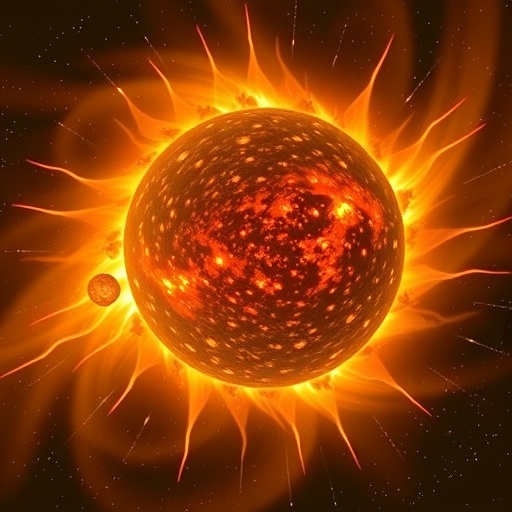For the first time, astronomers have meticulously observed the evolution of the iconic Planetary Nebula (PN) IC418, commonly known as the “Spirograph Nebula,” over an extraordinary time span of 130 years. This period of observation encompasses nearly double the average human lifespan, marking a significant leap in the study of stellar evolution. The findings were recently published in the renowned journal Astrophysical Journal Letters by a collaborative team led by Professor Albert Zijlstra from The University of Manchester and Professor Quentin Parker from The University of Hong Kong.
Historically, IC418 has been a subject of fascination in the astronomical community, being one of the earliest discovered PNs and among the brightest, making it relatively easy to study. PNs like IC418 are the stunning luminous shells expelled by dying stars, enveloping the ejected gas that becomes excited and ionized by the hot remnants of the stellar core. What remains of the original star evolves into what we know as a white dwarf—a small entity roughly the diameter of Earth but containing about 0.6 times the mass of our Sun.
The remarkable aspect of the recent findings is not just the lengthy duration of observation but also the implications for our understanding of stellar evolution. Traditionally, existing models suggest that the processes governing stellar lifecycle transitions, particularly for PNs like IC418, occur relatively quickly. However, the new data indicates a much slower evolutionary process, suggesting that updates to these models may be necessary. Moreover, these observations suggest that the upper mass limit for the formation of carbon stars—those massive entities that have evolved from stars akin to IC418—could also be lower than previously predicted.
The extensive observations of IC418 span back to its first spectroscopic observation in 1893. During this early study, astronomers began to identify the various emissions from the nebula. Notably, the emissions from elements like Hydrogen, Oxygen, Nitrogen, and Sulfur are characterized by narrow lines in the nebula’s spectrum, providing vital insights into its composition and evolution. Over the decades, advancements in technology have transformed observational techniques, evolving from human visual measurements to sophisticated electronic cameras and today’s advanced solid-state CCD detectors, which have yielded progressively intricate data.
Recent analyses have revealed significant changes in the emission lines of IC418 over the span of 130 years. Specifically, the ratio of the H-beta emission line of hydrogen to the doubly ionized oxygen line ([OIII]) has demonstrated considerable evolution, underlining the notion that the nebula’s evolution is indeed measurable over such an extended period. This level of significant change has been noted as the fastest evolution observed within a PN, marking a historic achievement in astronomical research.
One of the key challenges faced by the researchers was reconciling disparate spectroscopic measurements taken over a century. The consistency in line ratios required meticulous vetting, evaluation, and extensive testing to produce reliable and usable data across various observational epochs. Understanding the star’s evolution necessitated using existing stellar evolutionary models and refining them to reflect the newly acquired data accurately.
According to Professor Parker, one of the co-authors of the study, the importance of this research lies in its unique position to provide direct evidence regarding the evolution of PN central stars. The extensive collaboration on the project, involving data collection, verification, and analysis, represents an extraordinary effort that transcends mere observational studies. It emphasizes the integration of historical data and modern models to provide a more thorough understanding of these celestial phenomena.
Adding to this sentiment, Professor Zijlstra pointed out the often-overlooked value of historical scientific data. In this instance, the past observations revealed the fastest evolution of a typical star that has been directly recorded, challenging the notion that the cosmos is unchanging. The researchers urge the astronomical community to consider the implications of this finding seriously and to revise existing models that govern our understanding of stellar life cycles.
As an extension of this groundbreaking work, the team looks to further investigate the detailed mechanisms of stellar evolution among PNs, as well as the factors influencing the mass of stars that evolve into carbon stars. The implications of their research extend beyond IC418, prompting a reevaluation of the broader understanding of planetary nebulae and stellar evolution at large.
The data employed for this research was amassed through over 130 years of published observations, with meticulous attention paid to the accuracy and consistency of spectroscopic measurements. It highlights the evolution of atomic emissions from the star and emphasizes the nebula’s ongoing transformation as the residual core continues to heat and evolve.
Astronomers are also encouraged to further explore the spectral characteristics of other PNs, as this innovative research lays the groundwork for evaluating stellar evolution at a larger scale. By linking the changing characteristics of star emissions to fundamental astrophysical processes, researchers can continue to untangle the complexities of stellar life cycles and address the mysteries of our universe.
In conclusion, this pivotal research not only underscores the extraordinary complexities of stars and their evolution but also serves as a beacon of inspiration to the scientific community. By illustrating the dynamic nature of celestial phenomena like IC418, researchers hope to motivate ongoing inquiry and exploration into the ever-changing cosmos.
Subject of Research: Stellar Evolution of Planetary Nebula IC418
Article Title: The Secular Evolution of Planetary Nebula IC 418 and Its Implications for Carbon Star Formation
News Publication Date: 20-Aug-2025
Web References:
References:
Image Credits: NASA (adapted from original Hubble Space Telescope image)
Keywords
Stellar Evolution, Planetary Nebulae, IC418, Carbon Stars, Astrophysics, Hubble Space Telescope, Emission Lines, Spectroscopy, Historical Data, Astronomy Research, Cosmic Phenomena




